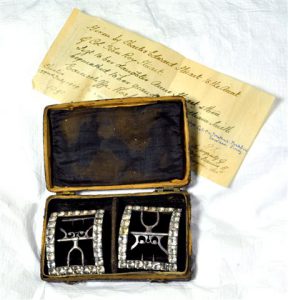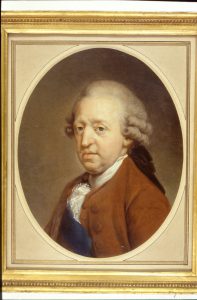Bonnie Prince Charlie’s shoe buckles (ref. MS 93.10f)
The Amulree collection of material relating to the Jacobites was gathered by Lord Amulree (1900-1983) and was bequeathed to the University in 1983. Basil Mackenzie, 2nd Baron Amulree, was a doctor specialising in geriatric care and a Liberal Peer in the House of Lords. He had a lifelong interest in the Jacobites. The shoe buckles are said to have belonged to Prince Charles Edward Stuart. The Jacobites sought to restore the Stuart monarchs to the British throne after the deposing of Catholic James II in 1688 in favour of Protestant William III and Mary. The Jacobite cause was particularly strong in the Scottish Highlands and in Ireland. Exiled in Europe, the Stuarts made several attempts to seize power in Britain. The two main risings were the First Jacobite Rising in 1715, led by Prince James Edward Stuart (‘The Old Pretender’) and the Second Jacobite Rising in 1745, led by Prince Charles Edward Stuart (‘Bonnie Prince Charlie’ or ‘The Young Pretender’). Both attempts failed, the latter ending in a crushing defeat for the Jacobites at the Battle of Culloden in April 1746.

The shoe buckles provide an enigmatic physical link to a tumultuous period of Scottish history. Reflecting on the objects Kathleen Jame, Professor of Poetry at the University of Stirling, wrote the following piece:
A portrait of Bonnie Prince Charlie by John Pettie shows him in full glamour, with plaid and jabot and sword – and with shoe buckles not unlike these. However, the picture was painted in 1898, long after Charles had died, drunk and failed, but when Jacobite romance still ran high.
The gems are not real diamonds, of course. They’re ‘paste’, as it says on the little piece of paper folded within the lid of the case. In this context ‘paste’ means a fine kind of glass. The paper also gives a pedigree or provenance for the buckles: it asserts that their claim to have been Charles’s is true.
This makes them a fine symbol for the whole Jacobite cause. Right down to their shoe buckles, whether they were rightful monarchs, or mere ‘Pretenders’, the Stuarts were caught up in declarations of right and authenticity, claim and counter-claim.
And if these buckles ‘really’ belonged Charles Edward Stuart, could he have been wearing them when his army passed through Stirling in 1746? Or perhaps when he set first foot in Scotland, on the island of Eriskay? Had he taken the advice he received there, to turn heel, sail home and forget about the British throne, well – what would be different now?


Recent Comments